Foot Prosthesis
M1170 J-Foot
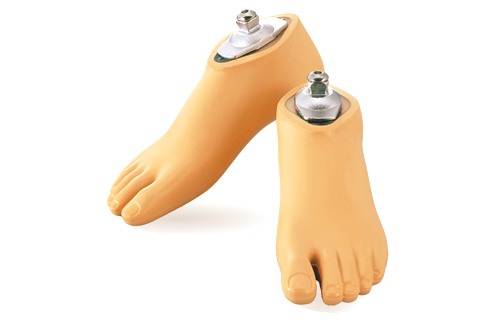
"Don't hinder me from walking." Here's our response to this obvious need.

| Activity Level |  |
|---|---|
| Body Weight Limits | (22~26cm)80kg (27~29cm)100kg |
Product Features
The J-Shaped Carbon Keel
The J-Foot is an energy-storing foot prosthesis made from carbon fiber reinforced plastic (CFRP). The J-shaped carbon keel allows graceful strides and gentle heel-ground contact with outstanding impact resistance, offering the appropriate repelling force while walking.
The type of foot prosthesis to which J-Foot belongs is the most commonly used type in Japan. It's been used over 20,000 times since its introduction, and the subjective appraisal it receives from its users is that "it's a foot prosthesis that doesn't hinder me from walking." This seems obvious enough, but it's quite difficult to build a prosthetic foot — an artificial device — that will not hinder the normal way of walking and will give someone the freedom to walk without limitations. Nonetheless, this appraisal affirms for us that we have succeeded in developing the J-Foot as something made by Japanese, for Japanese, so that they can carry out the unique activity of walking naturally.
The J-Foot offers a comfortable walk to all those seeking a pleasant, natural way to walk.
Ideal for All Users
Users can choose from among three varieties — soft, medium, and hard (hard only available for 27–29 cm keels) — the optimal keel hardness that suits their level of activity and favorite ways of walking, from "casual strolls" to "light exercise (up to jogging)." Except for users who want early sole-ground contact and who need to function under heavy exercise levels, the J-Foot is ideal for all users.
J-Foot Varieties
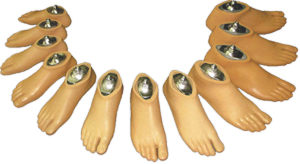
The J-Foot series is appropriate for both children and adults, with a full 12 sizes available ranging from 18 to 29 cm.
From children's sizes to large sizes, the J-Foot can be used by a wide range of users.
| Body Weight Limit | Keel Hardness | Color | Size |
|---|---|---|---|
| 80kg | Soft | Red | 22-25cm |
| 80kg | Med | Yellow | 22-26cm |
| 80kg | Hard | Green | 23-26cm |
| 100kg | - | - | 27-29cm |
J-Foot Selection Guide
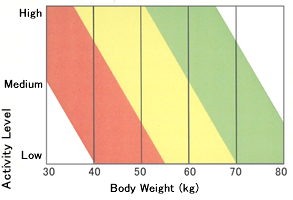
Activity Level
High : Running speed up to jogging
Medium : Normal walking
Low : Casual strolling
Note:
*You cannot exceed the given weight limit for a given J-Foot model regardless of keel hardness.
*Active users should choose a keel that is one rank harder.
*For reasons of safety, when a J-Foot's durable life has been exceed, it should be replaced with a new one.
Children's J-Foot: The JJ (Juvenile J-Foot)
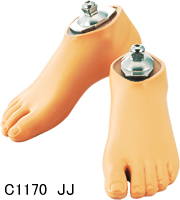
The JJ is our children's J-Foot, redesigned specially for children using the same J-shaped carbon keel as the regular J-Foot. The 18–20 cm sizes have one keel hardness available, while the 21 cm size is available in two hardness varieties, soft and medium.
JJ connects to the standard children's SACH adaptor, but the 20 and 21 cm sizes can be altered to fit an adult SACH adaptor if you specify this when ordering. (Note: there is a weight limit of 45 kg.)
JJ Varieties
| Body Weight Limit | Keel Hardness | Color | Size |
|---|---|---|---|
| 45kg | - | - | 18-20cm |
| 45kg | Soft | Red | 21cm |
| 45kg | Med | Yellow | 21cm |
JJ Selection Guide
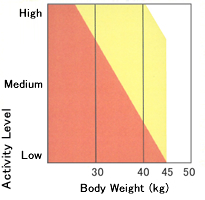
Activity Level
High : Running speed up to jogging
Medium : Normal walking
Low : Casual strolling
Note:
*You cannot exceed the given weight limit for a given J-Foot model regardless of keel hardness.
*Active users should choose a keel that is one rank harder.
*For reasons of safety, when a J-Foot's durable life has been exceed, it should be replaced with a new one.
The Concept
A Comment from the Developer
When we developed the J-Foot, there were already many energy-storing prosthetic feet on the market, and as a latecomer to the market, we had to develop a foot prosthetic that offered unique functionality. When we considered this, we decided on the following:
(1)It would demonstrate energy storage efficiency with small loads (bend easily).
(2)It would make it easy to walk indoors (smooth dorsal flexion).
(3)It would have good impact-absorbing abilities (make no sound during heel-ground contact).
(4)It would be lightweight (suitable for the elderly as well).
(5)It would be easy to use (SACH-compatible).
We set out to build a prosthetic foot that satisfied the five points above.
Design Points
- The heel includes a heel cushion to absorb the impact of heel-ground contact.
- By using the same carbon fiber reinforced plastic (CFRP) as is used for aircraft wings, the J-shaped carbon keel would bend smoothly during step-down, from sole-ground contact until the heel was lifted, storing enough energy for push-off.
- We did our best to create a foot that visually resembled a Japanese foot in shape, and we emphasized functionality that would make the foot easy to detach and reattach, so that Japanese practices like wearing shoes outdoors and removing shoes indoors could be followed.
Usability
Our number-one objective in development was to create a foot prosthesis that would remove as many restrictions as possible regarding the movement of Japanese foot prosthesis users. By giving motions such as running and jumping secondary consideration, and by focusing purely on "walking like normal," we managed to create a foot that was appraised by most users as "a foot prosthesis that doesn't hinder me from walking."
Product Specifications
| Module Number | M1170 | X1170 | C1170 | ||
|---|---|---|---|---|---|
| Product Name | J-Foot | J-Foot Exo | JJ | ||
| Body Weight Limit | 22-26 cm | 80kg | 18-21cm | 45kg | |
| 27-29cm | 100kg | ||||
| Keel Hardness | 22 | Soft and Med | 18-20cm | Soft and Med | |
| 23-26cm | Soft and Med and Hard | 21cm | - | ||
| 27-29cm | - | ||||
| Size | 22-29cm | 18-21cm | |||
The Origin of the Nickname
This is the second Lapoc product to be given a nickname since the M1150 Super Foot. The "J" in "J-Foot" comes from the "J" in the "J-shaped carbon keel," as well as the "J" in "Japan" owing to the fact it is a foot prosthesis made in Japan, by Japanese hands, for Japanese users. It can also be taken to mean "Just Fit," a phrase which sounds quite similar to "J-Foot."
It's been twelve years since development began on the J-Foot, but during that time we've received words of encouragement as well as harsh opinions from our customers, and while it might not be obvious from the outside, there have been many improvements made internally. We've been open to local input, not just for J-Foot, but so that we can follow the Lapoc philosophy — "to consider the user's needs from the user's standpoint" — and build products that reflect that as much as possible.
Getting the product into circulation doesn't mean development is finished, but one of the major features of Lapoc products is that because they are completely made in Japan, they are always being developed and improved even further.
These days, a surprisingly large number of people appreciate our products and consider them to be the standard in foot prostheses, saying things like "you can use them worry-free," and "if you can't decide, choose J-Foot." It's not an exaggeration to say, "if it's Lapoc, it's J-Foot," and now is the time to live up to its name as a Lapoc-branded product.
